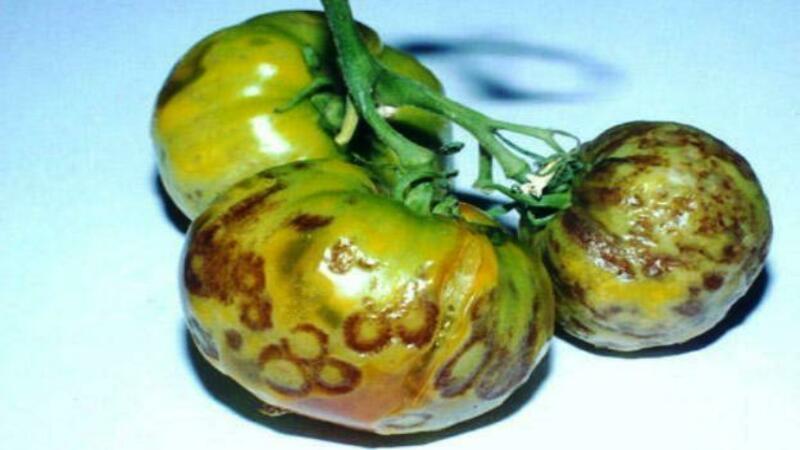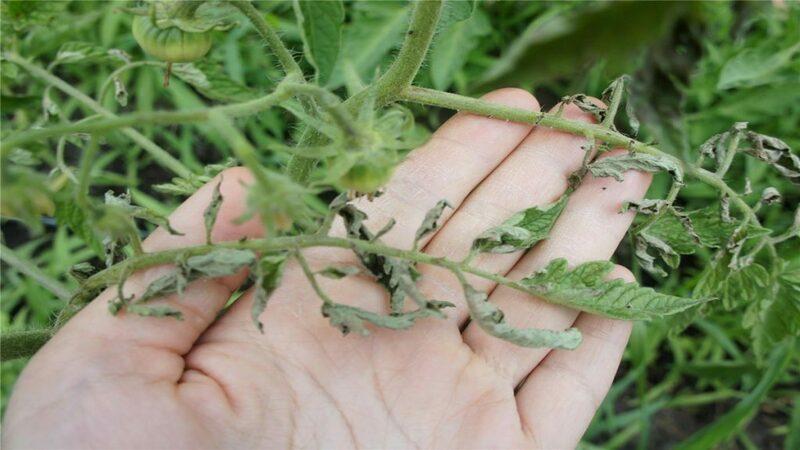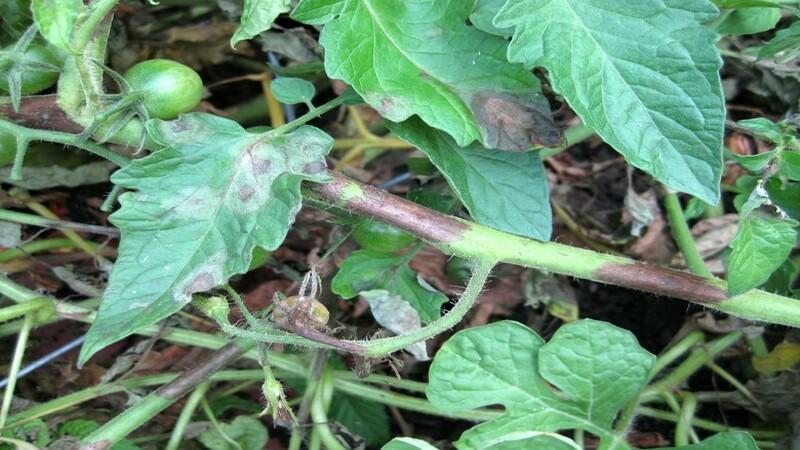We recognize the enemy by sight and effectively fight him: tomato streak and the best methods of treating this scourge
Tomato streak - dangerous diseasethat can ruin your entire crop if you do not take the necessary measures in time. The slightest spots on fruits or leaves should alert you. The sooner a virus is detected, the more likely it is to prevent its further spread. In the article we will figure out what a streak is and what infected plants look like, and consider how to treat them.
The content of the article
What is this disease
Streak is a viral disease, a kind of mosaic.
Translated from English streak - a strip, from German strich - a stroke. Therefore, tomato streak is also called striped spotting or streakiness.
The photo shows an example of an infected plant, in which stripes destroying it are clearly visible.
Influence on tomatoes
Streak can reduce the yield of tomatoes by 30-50%, and if the disease is advanced, you can lose the entire crop.
Under the influence of the virus, the fruits stop growing, and the taste also deteriorates. Therefore, if it seems to you that outwardly everything is not so bad (you can cut off a small damaged area), and the taste is completely different from what it should be, you should be wary.
Important! The infection penetrates deep into the fetus and remains in the seeds. They are unsuitable for subsequent planting.

Symptoms and external signs: description of damage
The virus infects not only fruits, but also leaves with stems. Reddish to brown spots appear on them. The spots are small on the leaves. They gradually dry out and become very fragile. Long stripes of dead tissue appear on the stems, like cuts.
Green tomatoes are covered with spots of various shapes, which can eventually merge into one large. Small spots grow into elongated lesions. This leads to the tomato cracking and completely unusable.
Red ripe or ripening fruits are covered with uneven, depressed elongated spots, tomatoes are deformed and also crack over time.
The photo clearly shows the characteristic spots from the defeat of the fruit with tobacco mosaic.
Reasons for the appearance and infection
Let's take a closer look at what is the cause of tomato streak disease.
Causative agent of the disease
Distinguish between simple and complex streaks. The first is caused by the tobacco mosaic virus, and the second is caused by combining tobacco mosaic with F- and X-type potato viruses or cucumber mosaic.
Greenhouse tomatoes are usually susceptible to this virus, but ground tomatoes do not have pronounced immunity to it. The virus enters the fetus and begins to destroy it from the inside. Therefore, the most effective measure of getting rid of this disease will be its prevention and prevention.
Terms of distribution
The virus is transmitted mechanically. For example, during various garden manipulations with a vegetable: pinching, pinching, etc. Aphids also spread the infection. The development of a streak in a plant (incubation period) occurs within 10-14 days.
Low temperature (15-19 degrees), poor lighting and high humidity in the greenhouse - all this contributes to the rapid spread of the disease. An excess of nitrogen fertilizers can also stimulate its appearance.

How and what to treat
The tobacco mosaic virus is very difficult to treat, especially if a large number of plants are already infected.Therefore, it is very important to identify the onset of infection at the initial stage. Infected plants will have to be isolated from the rest and burned.
It is possible to get rid of a disease that has already manifested itself only by disinfection greenhouses.
There are several ways:
- Wet disinfection - after harvesting the remaining crop, it is necessary to eliminate plant residues. Prepare a 5% solution of potassium permanganate and spray all the inner surfaces of the greenhouse: tiles on the path, glass and other structures.
- Steaming the soil - during the day, it is necessary to maintain the temperature in the greenhouse at 70 degrees (or for two hours at 100 degrees).
- Biological way - after steaming, spray the ground with glyocladin.
- Agrotechnical - remove soil from the greenhouse, mix it with manure and lime (4 kg per 2.5 sq. m). Then spread out into piles 1.5-2 m high and 3 m wide. Leave for 2-3 years.
As complex as these methods seem, they really help. The virus can persist in the soil for several years, so it is better to take all the necessary measures right away than to suffer every year with newly manifested signs of the disease.
Chemicals
Initially, there is a chance to save tomatoes from the virus. Karbofos is an agent that prevents the spread of pathogenic organisms. For 10 liters of water, 75 g of powder is required. The diluted composition is applied to shoots and stems. You need to repeat the procedure after 10 days. This should be done with healthy plants that are in the same greenhouse as sick plants.
Fungicides can also help early in the spread of the disease. The most effective drugs are Maxim and Lamador. Fungicides have a special chemical composition that has a negative effect on most harmful microorganisms.
When using chemicals, it is important not to forget about protective equipment: glasses and gloves. Closed shoes should be used.
Traditional methods
The tobacco mosaic virus does not tolerate milk proteins well. Therefore, you can wash your hands and garden tools with them if you have not yet had time to purchase chemicals.
You can also make such a solution: mix 10 liters of water with 1 liter of milk, add 10 drops iodine... Spray the plant with a solution, repeat the procedure after a week. In some recipes, 1 tbsp is added instead of iodine. spoon of urea and 40 g of grated soap.
Since aphids are a carrier of this virus, it is quite advisable to start fighting these insects as well. Garlic plantings around the perimeter of a tomato garden or Dalmatian chamomile flowers will drive them away.
Agrotechnical techniques
Here is a list of agronomic measures for getting rid of the streak and its prevention:
- Choosing a landing site: it should be well lit, not waterlogged, ventilated.
- Use for planting only healthy and high quality seed.
- Thorough weeding of rows of beds and row spacings.
- Immediate removal of diseased plants.
Preventive measures
Here is a list of rules that reduce the risk of streak infection of tomatoes:
- Good lighting is essential for both seedlings and mature plants.
- There should be no sudden temperature fluctuations.
- Soaking the seeds in a 1% solution of potassium permanganate is mandatory.
- It is important to disinfect the soil with potassium permanganate before planting.
- Pickling should start with healthy tomatoes.
- Do regular weeding and thorough weeding.
- Replace greenhouse soil every year.
- Treat all gardening tools with 5% potassium permanganate solution.
- After contact with an infected plant, hands should be thoroughly washed with soap.
- It is not recommended to smoke near plantings: tobacco products can be contaminated, and its particles falling on plants are destructive for them.

Gardener tips
Experienced gardeners recommend cutting the lower leaves after fruit ripening to improve ventilation.
Regular feeding with solutions with zinc, manganese, copper and boric acid will have a positive effect on the immunity of tomatoes.
Gardeners from the southern zone of Russia are advised to grow a seedless tomato crop: this also helps to reduce the chances of mosaic infestation.
Conclusion
Tomato strick is a disease of tomatoes that is difficult to recognize and treat. Despite this, you should not despair: modern chemicals will help you cope with the misfortune. Do not ignore the folk methods.
The main thing is to remove diseased plants in a timely manner and constantly carry out preventive measures to prevent infection with tobacco mosaic.